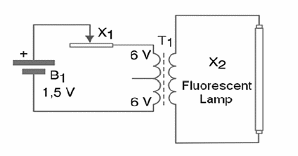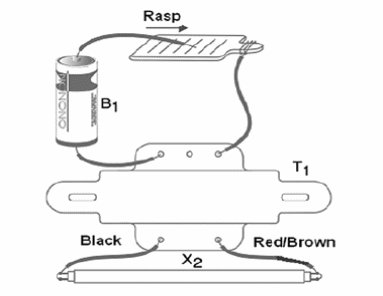This is a very easy project. Can be used with students starting from 8 years old (middle school). In fact, this is an experiment that allows you to show how transformers work. The circuit will step up the voltage of one or two cells (1.5 V or 3.0 V) to a value high enough to glow a fluorescent lamp. These lamps need something around 200 V or more to glow and this voltage can be produced by a transformer. The circuit also shows that transformers need changes in the current, operating only when the wire is scraped on the file. This means that the device can be used as a common inverter to power lamps in camping, or when the AC power line voltage fails. The only purpose for this circuit is demonstration.
The circuit is formed only by a transformer, a fluorescent lamp, one or two C or D cells and a file. Applying a low voltage to the transformer, the high voltage induced into the other winding is enough to glow the lamp, making it flick.
Observe that the induction process is dynamic, needing a constant movement of the wire on the file, to produce current changes. Figure 1 shows the diagram used to represent this experiment.

Figure 2 shows how the components are mounted for the experiment.

The recommended cell is a C or D type, since the current drain is high. You can also increase the output power using more than 1 cell. Use 2 or 4 cells in a holder. Any transformer with a primary rated to 110/127/220 or 240 V, and a secondary rated to 6 to 12 V and current up to 500 mA can be used.
Any fluorescent lamp between 5 and 40 W will glow in this circuit, even the weak ones that do not function any more in the normal appliances. Of course, only weak lamps can be tested, not the burned ones. X1 is any common file.
To operate the circuit you just have to scrape the wire against the file. The lamp will light up, producing short light flashes. Do not touch the wires connected to the lamp. They have high voltages and can cause severe shocks.
B1—1 to 4 C or D cells—with holder (optional)
X1—Common file
T1—Transformer—primary 110/117/127/220 or 240 V—secondary 3 to 12 V up to 500 mA—see text..
X1—Any fluorescent lamp—5 to 40 W—even weak units
Other:
Wires, solder, etc.



